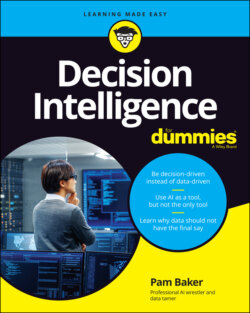Читать книгу Decision Intelligence For Dummies - Pamela Baker - Страница 40
DATA ANALYSIS RUTS AND ROAMS
ОглавлениеTraditional data mining processes usually look something like this:
1 Prep data from existing sources — such as systems used for routine business operations, streaming data, or data centers — for use in analytics.
2 Mine the data with a variety of tools, including analytics and machine learning (known commonly as AI).
3 Visualize the outputs — make graphic representations of the insights gleaned from analyzing the data, in other words.
4 Decide what action to take based on these insights.
5 Refresh the data and then rinse and repeat.
Unfortunately, data miners and data scientists often hand over the results of their hard work only to find that nothing came of it because there was no realistic business plan to use them in the first place. By comparison, decision intelligence ensures a plan is in place from the outset.
Still, there’s no reason to throw out the traditional data mining process when you make your move to decision intelligence. Indeed, you’d be nuts to do that. This process works quite beautifully in many use cases — most notably, those that are unmuddied by nuance, gray areas, and language confusions. For example, is the color yellow meant to signify Caution or Coward in any given data set? That may depend on one of those gray areas, which, in this particular case, is bound up in context. Data scientists are quite familiar with these issues and deal with them every day.
More defined questions are arguably better suited to how analytics are positioned in this process. For example, it’s true that predictive analytics will be correct more often than humans in determining the last day of usefulness of a machine part. It’s also true that analytics will be accurate more often than people — even experts — in detecting patterns in massive amounts of data.
But it’s also important to understand the limitations of this approach. Machines can do only so much. They don’t think or learn as you and I do. For example, machine learning can sort data faster than humans in any this-is-a-cat-this-is-not choice of well-defined options. But even then, machines are likely to mislabel a few cat pictures that a human child would instantly recognize to be distinctly feline.
By comparison, decision intelligence melds your mind to the machine’s “mind” so that the strengths of each one overcome the other’s weakness. Obviously, it’s not an actual melding of human and machine, but rather a blend of decision capabilities.
That’s a vital advance because it renders outputs of greater significance to problem solving and additional analysis of real world impacts. An unintended side effect of using the traditional model was the devaluation of the worth of human input outside of programming and other software development activities. We humans got into the habit of putting total faith in algorithm outputs — even when the outputs are in conflict with our thoughts and experiences. We do this despite it being well known that data is rarely perfect or complete. But that’s not the only problem challenging our blind faith in data analysis.
Unfortunately, as Cassie Kozyrkov, Google’s head of decision intelligence, often reminds us: “Strategies based on pure mathematical rationality are relatively naïve and tend to underperform.”
Anyone who has been chased by ads — for items they have already purchased and don’t care to buy again — across social media and the Internet can attest to this most annoying “relatively naïve” underperformance of some analytics.
Even so, general wisdom still has it that data — and not people — should take the lead in business decisions. It’s machine over gut instinct every time, goes the mantra, even when that isn’t done in practice. But why must this be an either-or question? The correct answer, of course, is that it doesn’t.
Enter decision intelligence, the practitioners of which “usually emphasize details of broad business decision systems; these include analytics, management of data and information resources, business rules, integration of decisions into operational systems and other functions,” according to Meta Brown, the author of Data Mining For Dummies.
The aha moment here is that analytics and data mining are parts of the decision-making process rather than the whole of it.
Decision intelligence is a huge umbrella under which all the activities necessary to produce decisions huddle and are put into practice to yield a preset, desired outcome.
Predictable and even preset questions are still good questions in many business pursuits. There’s nothing wrong with continuing to interrogate the data in this way for many common use cases. After all, you always want to know your sales for the day and how that number compares to last year’s sales. And, you likely always want to know which products are hot sellers this week, which employees were the most productive, and so forth. So go ahead and keep asking the data these questions.
But it’s time to see what else you can do with data and analytics and AI. It’s time to rethink how to go about the business of deriving decisions at scale as well. And that is exactly how some in the data sciences arrived at decision intelligence.
How do you break out of the boxed-in thinking behind traditional data mining processes? Think How before What. Figure out how to go about making the decision rather than focus in on what the data says in answer to your query.
